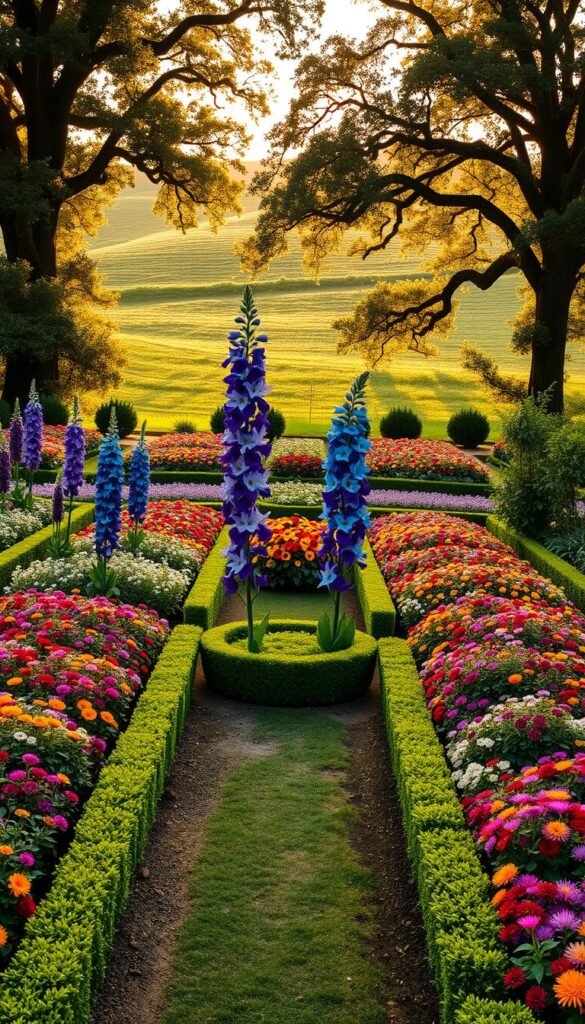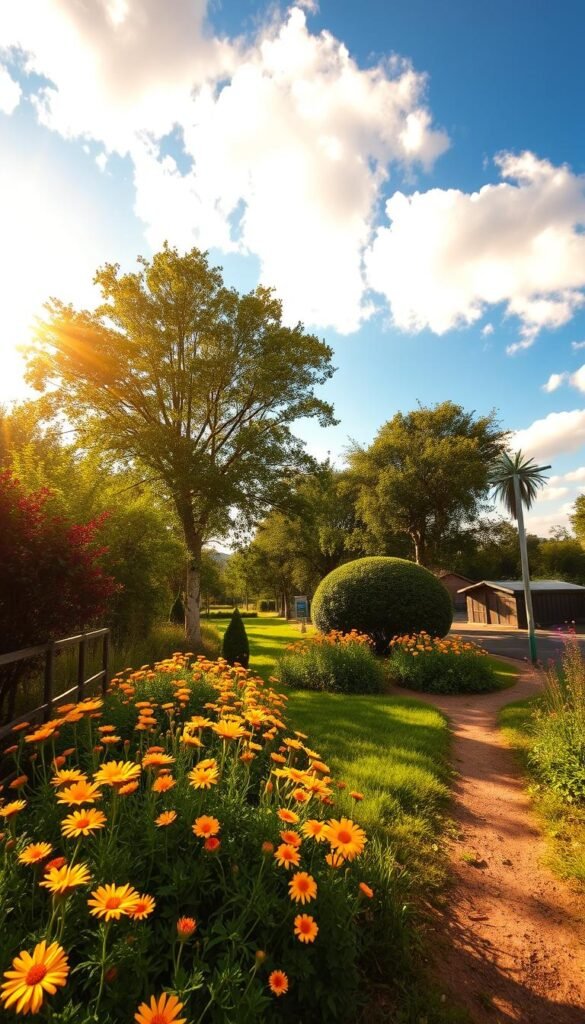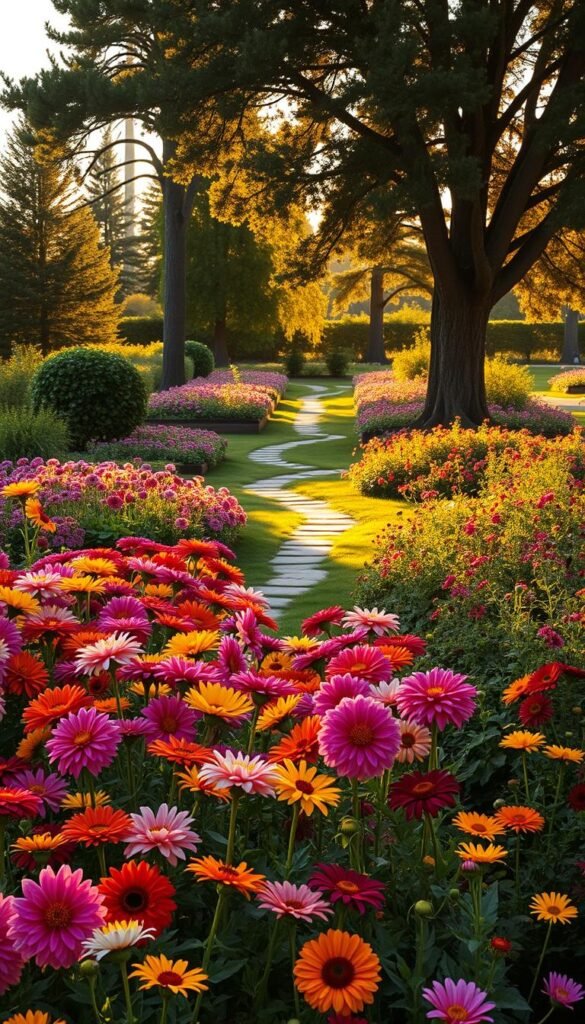Imagine filling your home with fresh arrangements that last longer than store-bought stems. A dedicated growing space lets you snip vibrant blossoms right from your yard or patio. Unlike traditional plots meant for visual enjoyment, these productive areas prioritize abundant blooms ready for indoor display.
You might picture vast fields of roses, but even a 4×4 foot bed can yield surprising results. Fast-growing annuals like zinnias and sunflowers deliver armfuls of color in weeks. Perennials like lavender add texture while attracting pollinators to your green oasis.
This approach blends gardening with creative design. You’ll learn to time plantings for continuous harvests and select varieties that thrive when cut. Picture arranging fiery marigolds one week and delicate cosmos the next—all from your personal patch.
Small-space solutions make this accessible to everyone. Container gardens on balconies or vertical planters against fences maximize every inch. With smart planning, you’ll enjoy 20+ bouquets per season without sacrificing curb appeal.
The magic lies in prioritizing productivity over perfection. Regular trimming encourages more blooms while letting you experiment with seasonal palettes. Soon, you’ll replace wilted supermarket bunches with living art that reflects your unique style.
Getting Started with Your Cut Flower Garden

Unlock the secret to non-stop blooms with smart design techniques. Successful arrangements require five essential categories: bold focals, vertical spikes, circular discs, lush fillers, and delicate airy elements. Each plays a specific role in creating showstopping bouquets.
Understanding the Basics of a Cutting Garden
Begin with easy-grow varieties that sprout directly in soil. Zinnias and cosmos eliminate transplant stress, while snapdragons add height. Herbs like mint double as fragrant fillers – practical choices for new growers.
Space plants closer than in decorative beds to encourage longer stems. Tall varieties belong at the north side of plots to prevent shading. Cluster moisture-loving species together for efficient watering.
Planning Your Garden Layout for Maximum Blooms
Map out beds using a simple grid system. A 10×10 area can produce 15+ weekly arrangements when planted densely. Leave narrow paths between rows for easy access to every stem.
Stagger planting dates every 2-3 weeks for continuous color. Pair early bloomers like larkspur with late-season stars like dahlias. This rhythm ensures fresh picks from spring through fall frosts.
Keep pruning shears and buckets near your plot for convenient harvesting. Smart placement near water sources saves time during hot summer months. Remember – functionality fuels creativity in productive spaces.
Choosing the Best Location for Your Cut Flower Garden

Sunlight fuels your blooms’ performance like backstage crew in a theater production. The right spot boosts stem strength and flower counts while reducing pest issues. Let’s explore how to find your plot’s sweet spot.
Finding a Sunny Spot with At Least 6 Hours of Direct Sunlight
Most flowering plants crave sunshine like solar panels. Track light patterns through three simple observations:
- Morning sun positions (east-facing areas)
- Midday shadows from structures
- Late afternoon tree coverage
Create a light journal using your phone’s camera. Snap pictures hourly between 9 AM and 5 PM for three consecutive days. Patterns emerge showing where shadows linger longest.
| Sun Exposure | Recommended Varieties | Bloom Duration |
|---|---|---|
| 8+ hours | Zinnias, Sunflowers | 10-12 weeks |
| 6-8 hours | Cosmos, Marigolds | 8-10 weeks |
| 4-6 hours | Snapdragons, Fuchsia | 6-8 weeks |
Assessing Soil Drainage and Space Considerations
Perform this quick drainage test after heavy rain:
- Dig 12-inch hole
- Fill with water
- Time how long it empties
Ideal drainage clears within 2-4 hours. Slow-draining areas need raised beds mixed with compost. Pair moisture-loving plants like hydrangeas with thirsty vegetables for efficient water use.
Urban growers can transform concrete spaces using 18-inch deep containers. Dwarf sunflower varieties thrive in these setups while providing cheerful focal points.
Essential Tools and Materials for a Successful Garden

Equip yourself with smart solutions that simplify maintenance while boosting productivity. The right setup prevents common frustrations and lets you focus on creating stunning arrangements.
Selecting Raised Beds and Quality Soil Mix
Modern kits make setup effortless. Pre-cut cedar boards with corner brackets assemble faster than wrestling with raw lumber. Prices often match DIY costs since 2023’s wood market stabilization.
Line beds with ¼” hardware cloth before adding soil. This metal mesh stops burrowing voles from destroying roots overnight. One gardener reported saving 40% of their snapdragons after implementing this barrier.
| Tool | Purpose | Pro Tip |
|---|---|---|
| Bypass pruners | Clean stem cuts | Sanitize weekly with alcohol |
| Landscape fabric | Weed control | Choose pre-marked grids |
| Soil thermometer | Planting timing | Check at 8 AM daily |
| Propane torch | Template creation | Use on calm days |
Invest in durable materials like DeWitt fabric. Its UV-resistant design lasts 5+ seasons and eliminates measuring with printed planting guides. Secure edges with 6″ staples – plastic versions crack in frost.
Mix 60% topsoil with 30% compost and 10% coconut coir for ideal drainage. This blend supports heavy feeders like dahlias while preventing waterlogged roots during summer storms.
Cut Flower Garden 101: How to Grow and Harvest Your Own Bouquet

Transform your growing space into a bloom factory by syncing with nature’s calendar. Successful arrangements demand precise timing – like conducting an orchestra where each plant plays its part at the right moment.
Understanding Bloom Cycles and Seasonal Timing
Spring starters like tulips and ranunculus kick off the show, followed by summer’s zinnias that regenerate after each cutting. Fall brings chrysanthemums that thrive in cooler temps. Track these phases using a simple color-coded calendar:
| Season | Key Players | Harvest Frequency |
|---|---|---|
| Spring | Tulips, Snapdragons | Every 5 days |
| Summer | Zinnias, Cosmos | Every 3 days |
| Fall | Mums, Rudbeckia | Weekly |
Stagger plantings every 14 days for non-stop color. Mix quick growers like marigolds with slow-developing dahlias. This strategy ensures you’ll always have components for complete arrangements – focal points, fillers, and textural elements.
Scheduling Your Harvest for Fresh Arrangements
Cut most blooms in early morning when stems are hydrated. Test zinnia readiness by gently shaking stems – if flowers stay upright, they’re prime for picking. Cosmos last longest when harvested as buds just starting to unfurl.
Create a rotation system using seasonal care strategies to protect late blooms from frost. Label plants with planting dates on waterproof tags for easy tracking. By mid-summer, you’ll be gathering armloads every Tuesday and Friday like clockwork.
Selecting the Right Flowers for Vibrant Bouquets

Professional arrangements balance five key shapes that work together like instruments in an orchestra. Start with bold focal blooms as your soloists, then add vertical spikes for rhythm. Fill spaces with circular discs and textural greenery before finishing with wispy accents that add movement.
Crafting Seasonal Combinations
Spring arrangements shine with tulip focal points paired with larkspur spikes. Summer’s star performers include dinnerplate dahlias and zinnias in bold hues. For autumn drama, pair chrysanthemums with ornamental grasses and dried seed pods.
Consider these reliable pairings across growing seasons:
| Season | Focal | Spike | Disc |
|---|---|---|---|
| Spring | Tulips | Snapdragons | Poppies |
| Summer | Zinnias | Celosia | Cosmos |
| Fall | Mums | Goldenrod | Rudbeckia |
Powerhouse Plants for Every Vase
Benary’s Giant zinnias dominate summer displays with 4″ blooms on 36″ stems. Their sturdy structure makes them ideal focal points, while smaller varieties like Zahara work as filler. Pair with airy cosmos that sway above the arrangement, creating depth and motion.
Dahlias offer endless color options but need support cages. For low-maintenance beauty, try beginner-friendly flowers like marigolds. Their flat, round shapes bridge gaps between focal blooms and feathery fillers.
Remember to grow multiple sizes within each category. Tall snapdragons anchor arrangements, while dwarf varieties add mid-height interest. This layered approach lets you create museum-worthy displays from your backyard harvests.
Preparing Your Soil for Optimal Growth
Think of your garden’s foundation as the secret sauce behind every stunning arrangement. The right soil blend feeds roots while preventing soggy disasters. Let’s mix up a powerhouse recipe that keeps plants thriving from seedling to vase.
Mixing Compost, Organic Fertilizer, and Coconut Coir
Start with 50% raised bed soil for structure. Add 40% compost – nature’s multivitamin that feeds microbes and releases nutrients slowly. The final 10%? Coconut coir outshines peat moss by holding 30% more water while protecting endangered peat bogs.
Throw in Flower-Tone organic fertilizer for a phosphorus boost. This magic dust encourages more buds instead of leafy growth. One gardener reported doubling her zinnia harvest after switching to this blend.
Ensuring Well-Draining Soil for Healthy Roots
Test drainage with a simple jar trick: Fill it with your soil mix, add water, and watch. Ideal blends drain completely in 2-4 hours. If water lingers, add perlite or coarse sand to loosen the texture.
Well-aerated earth prevents root rot while keeping moisture consistent. Strong roots mean sturdier stems that survive bouquets for 7+ days. Check pH levels monthly – most blooms thrive between 6.0-7.0. A $15 meter from your garden center does the job perfectly.
Remember: Vibrant arrangements begin underground. Nourish your soil, and it’ll return the favor with armloads of color all season long.






